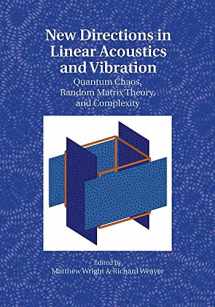
New Directions in Linear Acoustics and Vibration: Quantum Chaos, Random Matrix Theory and Complexity
ISBN-13:
9781107513457
ISBN-10:
1107513456
Edition:
Reprint
Author:
Matthew Wright, Richard Weaver
Publication date:
2015
Publisher:
Cambridge University Press
Format:
Paperback
286 pages
Category:
Civil & Environmental
,
Acoustics & Sound
,
Physics
,
Mechanics
,
Engineering
FREE US shipping
Book details
ISBN-13:
9781107513457
ISBN-10:
1107513456
Edition:
Reprint
Author:
Matthew Wright, Richard Weaver
Publication date:
2015
Publisher:
Cambridge University Press
Format:
Paperback
286 pages
Category:
Civil & Environmental
,
Acoustics & Sound
,
Physics
,
Mechanics
,
Engineering
Summary
New Directions in Linear Acoustics and Vibration: Quantum Chaos, Random Matrix Theory and Complexity (ISBN-13: 9781107513457 and ISBN-10: 1107513456), written by authors
Matthew Wright, Richard Weaver, was published by Cambridge University Press in 2015.
With an overall rating of 3.9 stars, it's a notable title among other
Civil & Environmental
(Acoustics & Sound, Physics, Mechanics, Engineering) books. You can easily purchase or rent New Directions in Linear Acoustics and Vibration: Quantum Chaos, Random Matrix Theory and Complexity (Paperback) from BooksRun,
along with many other new and used
Civil & Environmental
books
and textbooks.
And, if you're looking to sell your copy, our current buyback offer is $0.3.
Description
The field of acoustics is of immense industrial and scientific importance. The subject is built on the foundations of linear acoustics, which is widely regarded as so mature that it is fully encapsulated in the physics texts of the 1950s. This view was changed by developments in physics such as the study of quantum chaos. Developments in physics throughout the last four decades, often equally applicable to both quantum and linear acoustic problems but overwhelmingly more often expressed in the language of the former, have explored this. There is a significant new amount of theory that can be used to address problems in linear acoustics and vibration, but only a small amount of reported work does so. This book is an attempt to bridge the gap between theoreticians and practitioners, as well as the gap between quantum and acoustic. Tutorial chapters provide introductions to each of the major aspects of the physical theory and are written using the appropriate terminology of the acoustical community. The book will act as a quick-start guide to the new methods while providing a wide-ranging introduction to the physical concepts.


We would LOVE it if you could help us and other readers by reviewing the book
Book review

Congratulations! We have received your book review.
{user}
{createdAt}
by {truncated_author}


